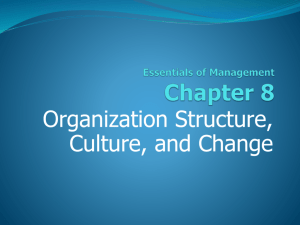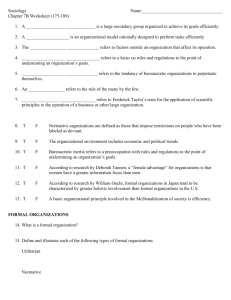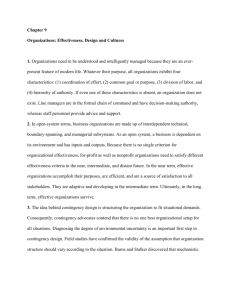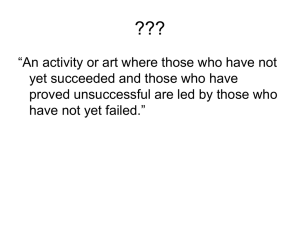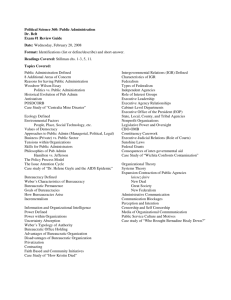Chapter-08
advertisement
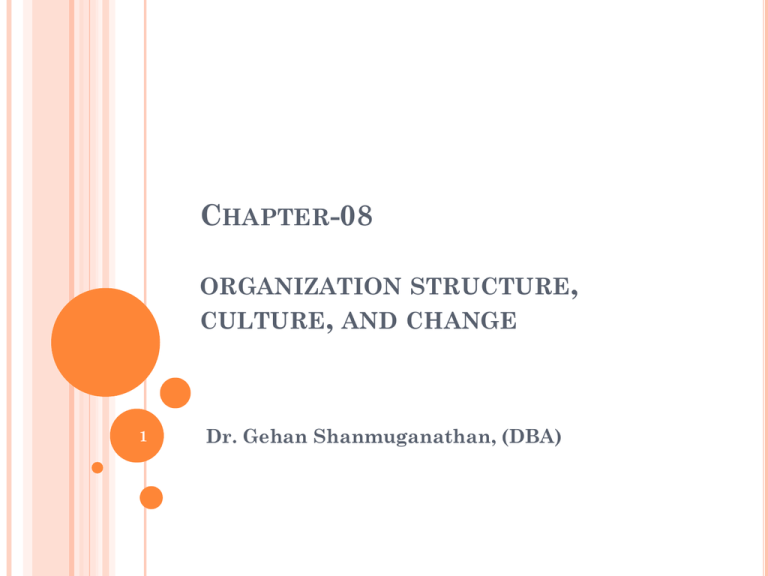
CHAPTER-08 ORGANIZATION STRUCTURE, CULTURE, AND CHANGE 1 Dr. Gehan Shanmuganathan, (DBA) PROCTER & GAMBLE 2 PROCTER & GAMBLE Changing the structure (positions) of the organization for cultural change 3 CHAPTER OBJECTIVES 4 9.1 LEARNING OBJECTIVES 1 Describe the bureaucratic organization structure and discuss its advantages and disadvantages. 2 Explain the major ways in which organizations are divided into departments. 3 Describe four modifications of the bureaucratic structure. 4 Identify key factors that influence the selection of organization structure 5 Specify how delegation, empowerment, and decentralization spread authority in an organization 6. Identify major aspects of organizational culture 7 Describe key aspects of managing change, including gaining support for change. BUREAUCRACY AS AN ORGANIZATION STRUCTURE 6 ORGANIZATION STRUCTURE The arrangement of people and tasks to accomplish organizational goals The structure specifies who reports to whom and who does what The structure specifies who has the power/authority The structure specifies how to communicate The structure specifies formal and informal social group behaviors 7 BUREAUCRACY A rational, systematic, and precise form of organization in which rules, regulations, and techniques of control are specifically defined 8 PRINCIPLES OF ORGANIZATION IN A BUREAUCRACY 9 PRINCIPLES OF ORGANIZATION IN A BUREAUCRACY Hierarchy of authority- each lower organizational unit is controlled and supervised by a higher one Unity of command- each subordinate receives assigned duties from one superior only and is accountable to that superior Task specialization- division of labor is based on task specialization Responsibilities and job description Line and staff functions 10 THE BUREAUCRATIC FORM OF ORGANIZATION High Few TopLevel Managers Power and Authority Number of Employees Middle-Level Managers First-Level Managers Operative Employees Low Many 9.2 ADVANTAGES AND DISADVANTAGES OF BUREAUCRACY 12 ADVANTAGES AND DISADVANTAGES OF BUREAUCRACY Advantages Know who is responsible for what Helps vertical integration Knows who has the authority to make decisions Disadvantages Rigid in handling people and problems Create inconvenience and inefficiency Competition between departments Frustration caused by red-tape Slow decision making 13 DEPARTMENTALIZATION 14 DEPARTMENTALIZATION The process of subdividing total work into departments 15 FUNCTIONAL DEPARTMENTALIZATION An arrangement that defines departments by the function each one performs, such as accounting or purchasing The advantage is to increase functional efficiencies 16 GEOGRAPHIC DEPARTMENTALIZATION An arrangement of departments according to the geographic area or territory served Advantage is that it allows for decision making at a local level, where the personnel are most familiar with the problems and the local culture, including taste, fashion, and food 17 PRODUCT- SERVICE DEPARTMENTALIZATION The arrangement of departments according to the products or services they provide Advantage is to increase the product management efficiencies 18 MODIFICATIONS OF THE BUREAUCRATIC ORGANIZATION 19 9.4 Matrix Organization Team Structure Non-bureaucratic Forms of Organization Organization by Process (Instead of Task) Flat Structures, Downsizing, and Outsourcing PROJECT AND MATRIX ORGANIZATION Project organization- A temporary group of specialists working under one manager to accomplish a fixed objective Matrix organization- a project structure superimposed on a functional structure These organizations are capable of managing the complexity 21 MATRIX ORGANIZATIONAL STRUCTURE 22 FLAT STRUCTURES, DOWNSIZING, AND OUTSOURCING 23 FLAT ORGANIZATION STRUCTURE A form of organization with relatively few layers of management, making it less bureaucratic Less span of control (number of subordinates reporting directly to a manager ) 24 DOWNSIZING OR BUSINESS PROCESS REENGINEERING (BPR) Laying off employees temporarily or permanently business process redesigning or engineering The key motives of the downsizing are; Less bureaucratic Low cost Higher profits and stock value Downsizing also could be expensive Early retirement pay Disability claims Lower productivity due to staff low moral Against the social responsibility 25 OUTSOURCING The methodology of giving out part of the entire business process to achieve cost, time, and quality benefits by focusing on the organization core competencies Advertising Research Promotions campaigns Productions 26 HOME SHORING Moving customer service into workers’ homes as a form of telecommuting 27 THE HORIZONTAL STRUCTURE (ORGANIZATION BY TEAM AND PROCESS) 28 HORIZONTAL STRUCTURE The arrangement of work by multidisciplinary teams that are responsible for accomplishing a process New product development Marketing research Quality teams 29 HORIZONTAL STRUCTURE 30 REENGINEERING The radical redesign of work to achieve substantial improvements in performance Switching from a vertical (task) emphasis to horizontal (process) emphasis could be done through reengineering 31 FOCUS OF TEAM OR PROCESS STRUCTURE Reduce cycle time Reduce cost Reduce throughput time Team members; Need to develop a process mentality rather than a task mentality 32 A TEAMWORK FORMULA Forming, Storming, Norming, Performing Individual Trust Group Team 4 stages Triangle Cohesiveness [Bond] Team Congruence TEAM APPROACH TO A PROCESS Collective Efforts A Results B C INFORMAL ORGANIZATION STRUCTURE AND COMMUNICATION NETWORK 35 INFORMAL ORGANIZATION STRUCTURE A set of unofficial relationships that emerge to take care of events and transactions not covered by the formal structure Social network analysis- the mapping and measuring of relationships and links between and among people, groups, and organizations Discuss how informal networks could be influenced by the information technology. E.gemails, Skype, video conferencing 36 POWER SHARING AT THE HIGHEST LEVEL OF MANAGEMENT 37 POWER SHARING AT THE HIGHEST LEVEL OF MANAGEMENT Top of the organization has the highest level of power Current trend is that one person holds two or more positions such as CEO and Chairman This avoids the confusion of understanding of “who has the ultimate power to control” This is designed in line with the flexible or matrix organizations concept 38 KEY FACTORS THAT INFLUENCE THE SELECTION OF AN ORGANIZATION STRUCTURE 39 KEY FACTORS THAT INFLUENCE THE SELECTION OF AN ORGANIZATION STRUCTURE Strategy and goals - structure follows the strategy Technology – high-tech companies use flexi organizations as technology connects worker, supplier, and customer Size – higher the size of the organization, highly centralized the control would be Financial condition of the firm – flatter organizations to reduce the cost factor Environmental stability – when the business faces uncertain and unstable environments, they need flexi organizations 40 DELEGATION, EMPOWERMENT, AND DECENTRALIZATION 41 DELEGATION AND EMPOWERMENT Delegation- Assigning formal authority and responsibility for accomplishing a specific task to another person Empowerment- The process by which managers share power with group members, thereby enhancing employees’ feeling of personal effectiveness 42 9.5 INCREASING PRODUCTIVITY THROUGH DELEGATION AND EMPOWERMENT 1. Assign duties to the right people 5. Obtain feedback on the delegated task 4. Retain some important tasks for yourself 2. Delegate the whole task 3. Give as much instruction as needed DECENTRALIZATION AND CENTRALIZATION Decentralization- The extent to which authority is passed down to lower levels in an organization Centralization- The extent to which authority is retained at the top of the organization 44 ORGANIZATIONAL CULTURE 45 ORGANIZATIONAL CULTURE (CORPORATE CULTURE)- THE SOFT SIDE OF THE ORG: The system of shared values and beliefs that actively influence the behavior of organization members Subculture- a pocket in which the organizational culture differs from the dominant culture and from other pockets of the subculture 46 DIMENSIONS OF ORGANIZATIONAL CULTURE 47 DIMENSIONS OF ORGANIZATIONAL CULTURE Values – the organization’s philosophy expressed through values guides behavior on a day-to-day basis Relative diversity – the degree of homogeneity Resources allocations and rewards – resources allocation send messages to employee what is valued in the firm Degree of change – influences the organizational culture A sense of ownership – ownership of stocks will create a culture of commitment and loyalty Strength of the culture – strong cultures influence dayto-day behavior of the people 48 HOW WORKERS LEARN THE CULTURE 49 SOCIALIZATION The process of coming to understand the values, norms, and customs, essential for adapting to the organization 50 CONSEQUENCES AND IMPLICATIONS OF ORGANIZATIONAL CULTURE 51 9.7 CONSEQUENCES AND IMPLICATIONS OF ORGANIZATIONAL CULTURE Employee Productivity, Quality, and Morale The Culture of an Organization Affects Its Competitive Advantage in the Marketplace Person- Organization fit Direction of Leadership Activity Adapted from Exhibit 9.9 MANAGING CHANGE 53 9.8 THE CHANGE PROCESS To bring about change, you have to break old habits, then create and solidify new habits . . . Unfreezing Changing Refreezing Adapted from Exhibit 9.10 GAINING SUPPORT FOR CHANGE 55 Invest time in planning the change Allow for discussion and negotiation 2 8 Build strong working relationships Allow for participation 3 How to Gain Support for Change 7 Ask effective questions to involve workers 1 6 Gain political support for change 9.9 4 Point out the financial benefits 5 Avoid change overload SIX SIGMA Refers to a philosophy of driving out waste and improving quality, and the cost and the time performance of a company 57 WRITE FIVE KEY THINGS (AREAS) THAT YOU CAN CRITICALLY REMEMBER IN TODAY’S DISCUSSION 58 WHAT WE DISCUSSED TODAY? 59 9.1 LEARNING OBJECTIVES 1 Describe the bureaucratic organization structure and discuss its advantages and disadvantages. 2 Explain the major ways in which organizations are divided into departments. 3 Describe four modifications of the bureaucratic structure. 4 Identify key factors that influence the selection of organization structure 5 Specify how delegation, empowerment, and decentralization spread authority in an organization 6. Identify major aspects of organizational culture 7 Describe key aspects of managing change, including gaining support for change. WEEKLY ASSIGNMENT 61 WEEKLY ASSIGNMENT How can a manager tell whether an employee is resisting change? Discuss with examples. 62
